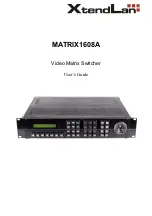
RMON
5-25
RMON and the Switch
RMON requires one probe per LAN segment, and
stand-alone RMON probes have traditionally been
expensive. Therefore, 3Com’s approach has been to
build an inexpensive RMON probe into the Smart-
Agent of each Switch. This allows RMON to be
widely deployed around the network without cost-
ing more than traditional network management.
A problem with stand-alone RMON probes is that
they are passive; able to monitor and report, but
nothing more. Placing probe functionality inside the
network device allows integration of RMON with
normal device management to allow proactive man-
agement.
For example, statistics can be related to individual
ports and the Switch can take autonomous actions
such as disabling a port (temporarily or permanently)
if errors on that port exceed a pre-defined thresh-
old. Also, since a probe needs to be able to see all
traffic, a stand-alone probe has to be attached to a
non-secure port. Implementing RMON in the Switch
means all ports can have security features enabled.
RMON Features of the Switch
details the RMON support provided by
the Switch.
Table 5-2
RMON support supplied by the Switch
RMON Group
Support supplied by the Switch
Statistics
A new or initialized Switch has one Statistics ses-
sion per port/VLAN.
History
A new or initialized Switch has three History ses-
sions on each 100BASE-TX port and the Default
VLAN:
■
60 second intervals, 120 historical samples
stored
■
30 second intervals, 120 historical samples
stored
■
30 minute intervals, 96 historical samples
stored
Alarms
Although up to 700 alarms can be defined for
the Switch, a new or initialized Switch has four
alarms defined for each port:
■
Bandwidth used
■
Broadcast bandwidth used
■
Percentage of packets forwarded
■
Errors per 10,000 packets
You can modify these alarms using an RMON
management application, but you cannot create
or delete them.
For more information about the alarms setup on
the Switch, refer to
“About Default Alarm Settings”
on
Summary of Contents for SuperStack II Switch 3000 10/100
Page 14: ...1 6 CHAPTER 1 GETTING STARTED Figure 1 2 Increasing port density with the Switch 3000 10 100 ...
Page 15: ...Unit Overview Front 1 7 Unit Overview Front Figure 1 3 Switch 3000 10 100 front view ...
Page 17: ...Unit Overview Rear 1 9 Unit Overview Rear Figure 1 4 Switch 3000 10 100 rear view ...
Page 22: ...1 14 CHAPTER 1 GETTING STARTED ...
Page 25: ...Configuration Rules with Full Duplex 2 3 Figure 2 1 Fast Ethernet configuration rules ...
Page 112: ...6 12 CHAPTER 6 STATUS MONITORING AND STATISTICS ...
Page 128: ...C 6 APPENDIX C TROUBLE SHOOTING ...
Page 129: ...D PIN OUTS Null Modem Cable 9 pin to RS 232 25 pin PC AT Serial Cable 9 pin to 9 pin ...
Page 130: ...D 2 APPENDIX D PIN OUTS Modem Cable 9 pin to RS 232 25 pin RJ45 Pin Assignments ...
Page 142: ...6 GLOSSARY ...
















































